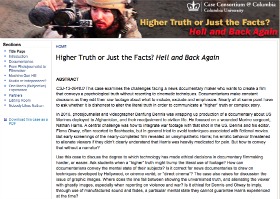The Case Method is an active-learning, discussion-based approach to teaching. By definition a “flipped classroom,” it differs from lectures, seminars, problem sets and other modes of instruction. It is used in the classrooms of professional schools in multiple disciplines—notably business, law, medicine, public policy, journalism, public health and education.
Case Method learning goes well beyond the rich content of the cases themselves. Students are able to practice behaviors and skills critical to success in the work world—analysis, leadership, management, negotiation, persuasion, teamwork, and public speaking. Students are asked to think for themselves, which develops critical thinking and judgment–essential abilities in any field. Case Method helps students enter the workplace prepared to lead.
Who uses cases?
Anyone who is trying to teach students, from undergrads to mid-career, to think in new ways about the real-world challenges of their chosen profession.
Case Method is commonly associated with law and business schools. But it is used increasingly in schools of journalism, public policy, public health and education. Both in the US and internationally, educators are in agreement that students in all fields deserve the chance to practice leadership and decisionmaking skills so that they graduate knowing how to navigate the real world.
The Case Method Classroom
In the Case Method classroom, students are put in the shoes of a protagonist facing a decision to which there is no single “right answer.” Students are expected to analyze the situation, identify the problem and who “owns” it, prescribe a solution, defend their views, persuade their colleagues, and/or amend their own position in the face of new information or persuasive arguments from others. These steps, repeated across case-based courses and classes, build judgment.The vicarious real-world experience students gain in the case classroom will stand them in good stead when they become industry leaders and managers in their own right.
The case classroom provides students with a non-threatening environment in which to practice newly forming habits of analysis, leadership and management. They develop critical thinking ability. While an instructor ensures a culture of respect for others, students learn to probe, question and examine assumptions. Students are encouraged to bring their own experiences to bear as they debate, among themselves and with the instructor, how best to approach the dilemma at hand.
The Case Study
The heart of the Case Method is the “teaching” case study, so-called because it is used as a vehicle for classroom discussion. The protagonist of a case is an individual (or unit) who faces a real-world professional dilemma. Based on interviews with those involved, a teaching case describes the political, financial, personal and other constraints on the decisionmaker in sufficient detail to allow for a nuanced and fact-based class discussion.
The most effective cases for classroom discussion are “decision forcing”—that is, the narrative stops at a critical turning point or decision point. There is urgency: as in real life, the decisionmaker has insufficient time, personnel or money to handle the situation optimally. Worst, s/he does not have all the information he would wish for. Nonetheless, the broadcast starts in an hour, or the minister wants a memo by 9 a.m., or the patient on the operating table needs immediate attention.

Sometimes case studies are “retrospective”: they tell an entire story from start to finish. Cases that describe “best practices” are also common, but in the classroom they lack the immediacy of a decision-forcing case.
Case topics are as various as the world we live in. The necessary ingredient is uncertainty or disagreement over the best next step. Some examples: how should the Christian Science Monitor respond to the kidnapping of a stringer?; should a New York hospital evacuate as a hurricane approaches?; how can a non-profit organization help an indigenous society without inadvertently destroying the native culture?
While most cases include an epilogue, an epilogue is not necessary pedagogically. Analytic learning and problem-solving can be all the more powerful when the “what happened” is left unanswered.
Case Method for Teachers
Case studies describe a real situation in which a decision must be made by a professional—a manager, employee or director. Unlike in a lecture class, a case instructor’s role is not to offer arguments, evidence and solutions, but rather to facilitate student discussion and create an environment for students to contribute and learn from each other.
With real-world stories, students are able to grapple with the kind of complex problems they will face during their careers. Case study instructors can guide students to see probable solutions and frame their decisionmaking in ways they had not previously considered. A fundamental principle of the Case Method is that the most enduring lessons are those which students teach themselves. By some yardsticks, an effective case teacher speaks only 15 percent of the time.
The foundation of any good case discussion is preparation, the students’ as well as the instructor’s. Teachers often assign study questions to guide students’ reading of the case and encourage preliminary conversation among classmates. Case teachers may also organize small student study groups that meet outside of class and help promote active engagement in discussions.
The case classroom should be a place where students can test ideas as they analyze problems presented in the narrative. Case instructors usually start class discussion with an open-ended question and call on individual students to contribute and support their ideas. At points during class, the instructor may summarize the debate, recap the issues, and ask the class to consider other aspects of the problem. The instructor may play devil’s advocate, or question the assumptions behind a line of argument. Many instructors use the end of class to review the key issues raised, or pose follow-up questions.
Instructors often choose to assign students other readings in conjunction with the case in order to give them better perspective, provide them with analytical tools, or to present a theory for which the case will provide a practical example.
Sometimes students leave a case discussion frustrated because there seems to be no right answer to the problem presented in the case. Students can be reminded that cases are drawn from the real world; that reality is gray, not black-and-white; that decisionmaking is rarely simple or straightforward; and that there are almost always numerous potential solutions to any given problem.
Most case studies include an epilogue. Whether to distribute it to students is, however, up to each instructor. The very frustration that comes from not knowing “what happened” can contribute to powerful and effective learning about the nature of decisionmaking, leadership and management.
Teaching Notes. Many cases include a Teaching Note for faculty. The Note is a rough roadmap to teaching the case. It is not, however, definitive. Each teacher will discover with repeated use of a particular case just how to employ it most effectively for his/her course.
Case Method for Students
Case studies describe a real situation in which a professional confronts a tough decision. Unlike in a lecture class, a case instructor’s role is not to offer arguments, evidence and solutions, but rather to facilitate student discussion and create an environment for students to contribute and learn from each other.
Before class, you will be asked to read a case and formulate strategy and recommendations as if you were the protagonist in the story. A journalism class might be asked, for example, how the Christian Science Monitor should respond to the kidnapping of a stringer; a public health class might consider the options for a hospital deciding whether to evacuate as a hurricane approaches. The paramount principle behind the Case Method is that the most lasting kind of learning happens when you, the student, are an active participant. The instructor will not tell you what the “answer” is; this hard work is up to you and your classmates.
In Case Method teaching, the instructor does not lecture but rather moderates a classroom discussion, highlighting and synthesizing the issues involved. Students learn from each other, as well as from the instructor, and together reach a deeper understanding of the dilemmas involved in the case. Students may also start to see how a theory or model works in reality. This is why students’ preparation for class is so important. You will be asked to share your insights and perspectives on the case, and to explain the reasoning behind them.
Most cases will require at least two read-throughs before you can begin to formulate your own position. Before class, try to imagine yourself as the decisionmaker and take his or her problem to heart. What would you do? What do you need to know to decide? What will be the consequences if you are wrong? Your instructor may want to focus on particular aspects of the case and furnish discussion questions in advance of class. As in real life, you may feel that you don’t have all the information to make the best decision, or that the information you do have is contradictory. You may want to assemble a team of “colleagues” to solve a challenging problem. Navigating the road to a decision asks you to consider real-world dilemmas and come to a better understanding of their political, practical and economic implications.
